Hearing Aids
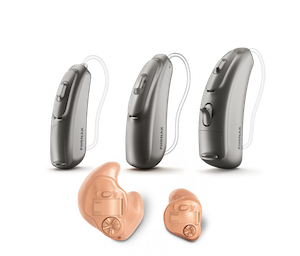
There are many different styles of hearing aids, based on the style they are worn (behind-the-ear or in-the-ear, for example). At the heart of it, hearing aids all have the same components – they are just housed differently based on the style. Some hearing aids are even completely invisible, worn deep inside the ear canal.
Hearing aids are designed with features to accommodate the many different aspects of hearing loss. Depending on the configuration of your hearing loss, your hearing specialist will recommend hearing aids with features to address your specific hearing needs.
Hearing Aid Styles
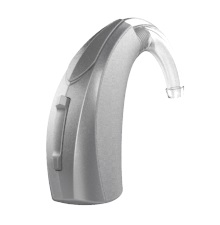
Behind-The-Ear (BTE)
BTE instruments’ technology is housed in a casing that rests behind the ear. A clear plastic tube then directs amplified sound into an earmold inside the ear canal.
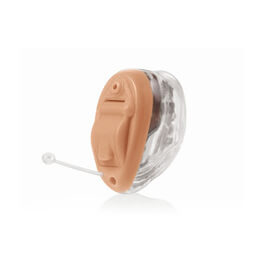
Completely-In-Canal (CIC)
These devices fit completely in the canal. Only the head of a tiny plastic line—with which you insert or remove the instrument—shows above the canal.
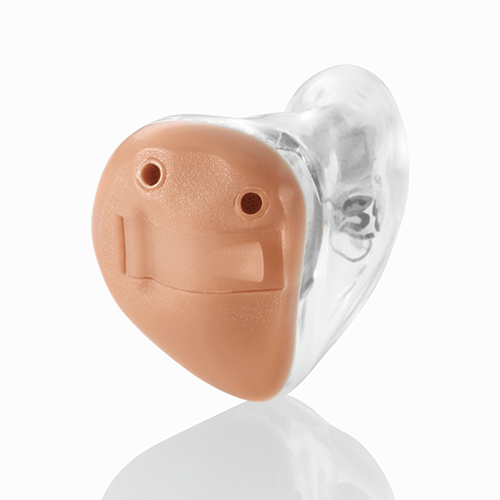
In-The-Canal (ITC)
In-The-Canal instruments feature an earmold that fits down into the ear canal and a smaller portion that faces out into the outer ear.
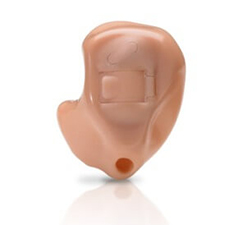
In-the-Ear (ITE)
In-the-ear instruments house the technology components in a custom-formed earmold that fits within the outer portion of the ear.
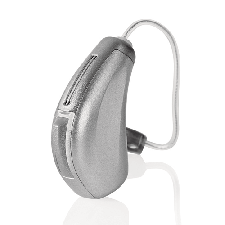
Receiver-In-Canal (RIC)
The receiver-in-the-canal device is small, discreet, and incredibly quick to fit; perfect for many first-time wearers.
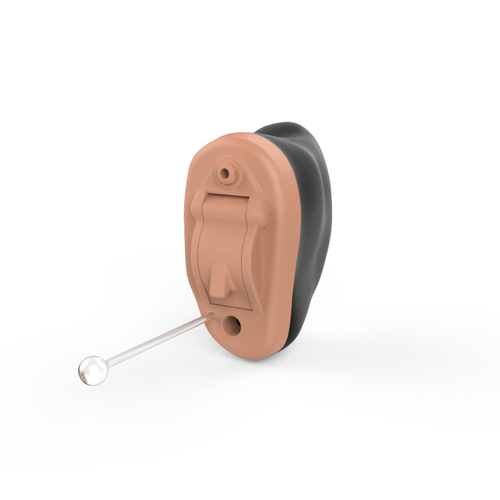
Invisible (IIC)
The receiver-in-the-canal device is so tiny, no one will notice you're wearing them.
Caring for Hearing Aids
Maintaining your hearing aids through daily cleaning and regular service is extremely important. The environment for in-the-ear hearing aids is moist and warm with relative humidity between 40-70% and a constant temperature of 98 degrees. Earwax, which is a combination of salt and corrosive body acid, can accumulate in the ears and on the hearing instrument.
Not surprisingly, these conditions can be harmful to electronics. Proper hearing aid care helps retain optimum hearing conditions, extends the life of your hearing aid, and ensures healthy ear hygiene.
How to clean your hearing aids
Select your hearing aid style on our instructional videos page to view how to clean your hearing aid.
Tips for cleaning your hearing aids:
- Remove earwax. It is important to remove earwax from your hearing aid to prevent temporary malfunction or permanent damage. When you purchase your hearing aids, you should receive cleaning tools including a soft brush and small picks or loops. Follow the manufacturer’s instructions for cleaning your hearing aids. If you cannot remove all the earwax, your hearing professional can help.
- When you remove your hearing aids at night, wipe them with a dry soft cloth. Do not use water, alcohol swabs or cleaning solvents as they can break down or damage your hearing aids.
Don’t drop your hearing aids
Dropping your hearing aids on a hard surface can damage the instruments. When you’re learning how to correctly place and remove your hearing aids, do it from a seated position with a towel or pillow on your lap.
Proper storage
- When not in use, keep your hearing aids away from heat and moisture and store them in a dry, cool place. Ask your hearing specialist about a dehumidifying box for storage. These boxes are designed to safely and effectively remove moisture that can corrode sensitive circuitry.
- Leave the battery door open to preserve battery power when not in use.
When not to wear your hearing aids
While most new hearing aids today are designed for water resistance, don't wear your hearing aids:
- In the shower or sauna
- Swimming
- When using a hair dryer
- While applying hair spray or other types of spray on products. Apply hair products first, and then insert your hearing aids.
Hearing Aid Features
Hearing aids are designed with features to accommodate the many different aspects of hearing loss. Depending on the configuration of your hearing loss, your hearing specialist will recommend hearing aids with features to address your specific hearing needs. Features commonly found in hearing aids include:
Wireless Connectivity – Equipped with Bluetooth technology, certain hearing aids are able to connect to smartphones or other electronic devices (tablets, home entertainment systems, car stereo systems, etc.). This allows hearing aid wearers to stream phone calls, music, and other media directly to their hearing aids.
Directional Microphones – With hearing loss, people struggle to focus on sounds, especially in noisy environments. Directional microphones are designed to help hearing aid wearers focus on the sounds they want to hear in challenging noise environments.
Telecoil – To provide extra amplification, some hearing aids are equipped with telecoils. Telecoils connect to hearing loops (an assistive listening option) in public spaces. The telecoil in the hearing aid picks up sounds streamed through electromagnetic waves from a public space’s PA system.
Digital processing platforms – Digital processing platforms process sound through filters and algorithms to balance the wearer’s listening experience. These ultra-fast and precise platforms are improved with each new model, essentially turning hearing aids into “mini computers”!
Moisture and Debris Resistance – Most hearing aids have an IP rating, which indicates the level of resistance a hearing aid has against moisture, sweat, dirt, and other debris. These elements may harm a hearing aid, which is why hearing aid manufacturers have designed devices to withstand certain levels of infiltration.
Speech Recognition – Hearing loss interferes with our ability to hear speech clearly, to anticipate speech patterns, and to understand voices at certain frequencies. This becomes increasingly difficult in noisy settings. All hearing aids have a speech recognition feature, to amplify speech sounds and also provide clarity.
Music Listening – While many traditional hearing aids focus on speech recognition, the experience of music listening has for many years been neglected. However, with new digital technology, hearing aids are better equipped to provide hearing aid wearers with excellent music listening features. There are settings for live music, recorded music, and for musicians who perform
Feedback Cancellation – Feedback is a frustrating experience with hearing aids. You might recognize them as that screeching sound when a microphone is too close to a speaker. This happens when amplified sounds are picked up by the microphone. Most hearing aids offer feedback cancellation features to anticipate feedback and eliminate it before it occurs.
Hearing Aid Components
Hearing aids are designed after the pattern of our audiological system. With normal hearing, our outer ear picks up sound from our environment. These sound waves travel through the middle ear, where they are amplified and turned into vibrations. These vibrations are sent to the brain by inner ear hair cells – tiny cells located in our inner ear. The vibrations become neural signals that follow pathways to the brain to be recognized as sound.
Depending on the type of hearing loss, this process is hindered at some point. Hearing aids are designed to pick up where our hearing falls short.
Microphone: The microphone picks up sound from the wearer’s environment and converts these sounds into electronic signals.
Amplifier: The amplifier does exactly what it sounds like – it makes sounds picked up from the microphone louder. These sounds are filtered to give wearers the sounds they prefer to hear, such as a person’s voice in conversation.
Receiver: After sounds have been amplified, the receiver converts the electronic signals into acoustic ones.
Digital chip: Each hearing aid is equipped with a processing chip, which essentially converts signals with algorithms and is the “small computer” that makes sure the hearing aid runs. All hearing aid program features are controlled by this chip.
Battery: Hearing aids are powered with batteries. With traditional hearing aids, batteries must be changed weekly or bi-weekly (depending on usage). Some hearing aids are equipped with rechargeable batteries, which requires an overnight charge for a day’s worth of energy.
Housing: Hearing aids are housed within plastic parts which are designed to protect the electronic components from moisture and dirt.





